MENU
The Electronic Scholarly Publishing Project: Providing access to classic scientific papers and other scholarly materials, since 1993. More About: ESP | OUR CONTENT | THIS WEBSITE | WHAT'S NEW | WHAT'S HOT
Comparative Timelines
The ESP Timeline (one of the site's most popular features) has been completely updated to allow the user to select (using the timeline controls above each column) different topics for the left and right sides of the display.
Select:
New Left Column
New Left Column
Dates
Decade
New Right Column
New Right Column
(no entry for this year)
1540
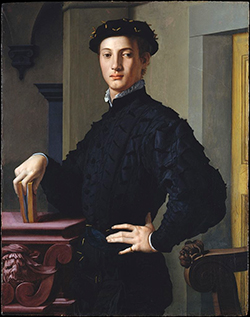 Painting by Agnolo Bronzino: Portrait of a Young Man with a Book The Portrait of a Young Man with a Book is a c.1530s oil on board painting by Agnolo Bronzino. It likely depicts a literary friend of the artist holding open a collection of poetry. It entered the Metropolitan Museum of Art in New York in 1929, where it is still held.
Painting by Agnolo Bronzino: Portrait of a Young Man with a Book The Portrait of a Young Man with a Book is a c.1530s oil on board painting by Agnolo Bronzino. It likely depicts a literary friend of the artist holding open a collection of poetry. It entered the Metropolitan Museum of Art in New York in 1929, where it is still held.
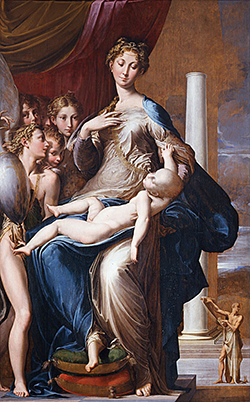 Painting by Parmigianino: Madonna with the Long Neck an Italian Mannerist oil painting depicting Madonna and Child with angels. The painting was begun in 1534 for the funerary chapel of Francesco Tagliaferri in Parma, but remained incomplete on Parmigianino's death in 1540. Ferdinando de' Medici, Grand Prince of Tuscany purchased it in 1698 and it has been on display at the Uffizi since 1948. The painting depicts the Virgin Mary seated on a high pedestal in luxurious robes, holding a rather large baby Jesus on her lap. Six angels crowd together on the Madonna's right, adore the Christ-child. In the lower right-hand corner of the painting is an enigmatic scene, with a row of marble columns and the emaciated figure of St. Jerome. A depiction of St. Jerome was required by the commissioner because of the saint's connection with the adoration of the Virgin Mary. The painting is popularly called "Madonna of the Long Neck" because "the painter, in his eagerness to make the Holy Virgin look graceful and elegant, has given her a neck like that of a swan."
Painting by Parmigianino: Madonna with the Long Neck an Italian Mannerist oil painting depicting Madonna and Child with angels. The painting was begun in 1534 for the funerary chapel of Francesco Tagliaferri in Parma, but remained incomplete on Parmigianino's death in 1540. Ferdinando de' Medici, Grand Prince of Tuscany purchased it in 1698 and it has been on display at the Uffizi since 1948. The painting depicts the Virgin Mary seated on a high pedestal in luxurious robes, holding a rather large baby Jesus on her lap. Six angels crowd together on the Madonna's right, adore the Christ-child. In the lower right-hand corner of the painting is an enigmatic scene, with a row of marble columns and the emaciated figure of St. Jerome. A depiction of St. Jerome was required by the commissioner because of the saint's connection with the adoration of the Virgin Mary. The painting is popularly called "Madonna of the Long Neck" because "the painter, in his eagerness to make the Holy Virgin look graceful and elegant, has given her a neck like that of a swan."
(no entry for this year)
1541
(no entry for this year)
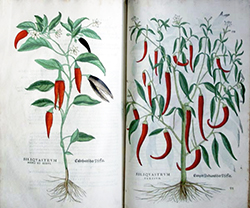 Leonhart Fuchs publishes his new herbal De historia stirpium commentarii insignes in Basel. It was illustrated by: Albrecht Meyer, who made drawings based on the actual plants; Heinrich Füllmaurer, who transferred the drawings to woodblock; and Vitus Rudolph Speckle, who cut the blocks and printed the drawings. It covers about 497 plants and has over 500 woodcut illustrations. Over 100 of the plants in the book were first descriptions. The University of Glasgow states that it is considered a landmark work in its field. Stanford University Press considers it one of the best illustrated books of all time and a masterpiece of the German Renaissance. It set a new standard for accuracy and quality, as well as being the first known publication of plants from the Americas, such as pumpkin, maize, marigold, potato, and tobacco. Plants were identified in German, Greek, and Latin, and sometimes English. The book was initially published in Latin and Greek and quickly translated into German. Just during Fuchs' lifetime the book went through 39 printings in Dutch, French, German, Latin, and Spanish and 20 years after his death was translated into English.
Leonhart Fuchs publishes his new herbal De historia stirpium commentarii insignes in Basel. It was illustrated by: Albrecht Meyer, who made drawings based on the actual plants; Heinrich Füllmaurer, who transferred the drawings to woodblock; and Vitus Rudolph Speckle, who cut the blocks and printed the drawings. It covers about 497 plants and has over 500 woodcut illustrations. Over 100 of the plants in the book were first descriptions. The University of Glasgow states that it is considered a landmark work in its field. Stanford University Press considers it one of the best illustrated books of all time and a masterpiece of the German Renaissance. It set a new standard for accuracy and quality, as well as being the first known publication of plants from the Americas, such as pumpkin, maize, marigold, potato, and tobacco. Plants were identified in German, Greek, and Latin, and sometimes English. The book was initially published in Latin and Greek and quickly translated into German. Just during Fuchs' lifetime the book went through 39 printings in Dutch, French, German, Latin, and Spanish and 20 years after his death was translated into English.
1542
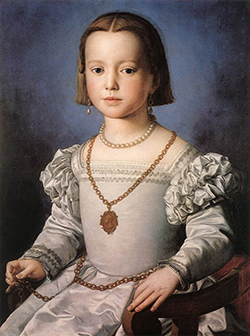 Painting by Agnolo Bronzino: Portrait of Bia de' Medici The Portrait of Bia de' Medici is an oil-tempera on wood painting by Agnolo Bronzino, dating to around 1542 and now in the Uffizi in Florence. Some art historians once identified the child as a young Cosimo I de' Medici, but it is now generally accepted to be Giulia.
Painting by Agnolo Bronzino: Portrait of Bia de' Medici The Portrait of Bia de' Medici is an oil-tempera on wood painting by Agnolo Bronzino, dating to around 1542 and now in the Uffizi in Florence. Some art historians once identified the child as a young Cosimo I de' Medici, but it is now generally accepted to be Giulia.
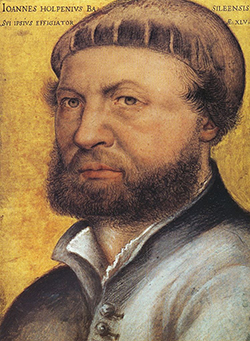 Painting by Hans Holbein the Younger: Self Portrait The Self-portrait is a small drawing by the German Renaissance artist and printmaker Hans Holbein the Younger, completed around 1542-1543, and housed in the Uffizi, Florence. The gold background was added later by a different artist. According to art historian John Rowlands, "Although this drawing has been enlarged on all sides and heavily reworked, enough of it still shows to allow the assumption that the original work was executed by Holbein.
Painting by Hans Holbein the Younger: Self Portrait The Self-portrait is a small drawing by the German Renaissance artist and printmaker Hans Holbein the Younger, completed around 1542-1543, and housed in the Uffizi, Florence. The gold background was added later by a different artist. According to art historian John Rowlands, "Although this drawing has been enlarged on all sides and heavily reworked, enough of it still shows to allow the assumption that the original work was executed by Holbein.
 Andreas Vesalius (Andries van Wesel) publishes the anatomy treatise De humani corporis fabrica (On the Workings of the Human Body).
Andreas Vesalius (Andries van Wesel) publishes the anatomy treatise De humani corporis fabrica (On the Workings of the Human Body).
1543
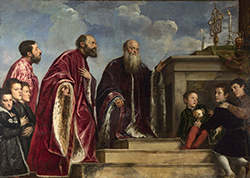 Painting by Titian: Portrait of the Vendramin Family a painting executed around 1543–1547. It presently hangs in the National Gallery in London. The canvas was commissioned by the noble Vendramin family, and portrays, as dictated by Venetian custom, only male members of the dynasty. It includes the brothers Andrea and Gabriele Vendramin, and Andrea's seven sons. Titian's painting has been described as, "one of the greatest group portraits in history". It balances youth and wisdom as well as demonstrating the power of this family and their public commitments to the Republic.
Painting by Titian: Portrait of the Vendramin Family a painting executed around 1543–1547. It presently hangs in the National Gallery in London. The canvas was commissioned by the noble Vendramin family, and portrays, as dictated by Venetian custom, only male members of the dynasty. It includes the brothers Andrea and Gabriele Vendramin, and Andrea's seven sons. Titian's painting has been described as, "one of the greatest group portraits in history". It balances youth and wisdom as well as demonstrating the power of this family and their public commitments to the Republic.
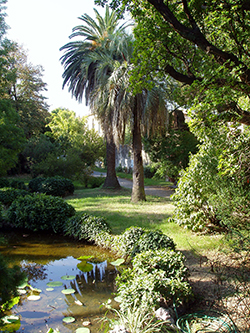 Orto botanico di Pisa botanical garden established by Cosimo I de' Medici, Grand Duke of Tuscany, under the direction of Luca Ghini, who also creates the first herbarium.
Orto botanico di Pisa botanical garden established by Cosimo I de' Medici, Grand Duke of Tuscany, under the direction of Luca Ghini, who also creates the first herbarium.
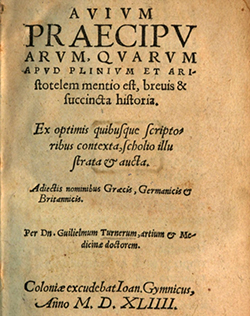 William Turner's Avium praecipuarum, quarum apud Plinium et Aristotelem mentio est, brevis et succincta historia is published in Cologne, the first printed book devoted entirely to ornithology.
William Turner's Avium praecipuarum, quarum apud Plinium et Aristotelem mentio est, brevis et succincta historia is published in Cologne, the first printed book devoted entirely to ornithology.
1544
(no entry for this year)
(no entry for this year)
1545
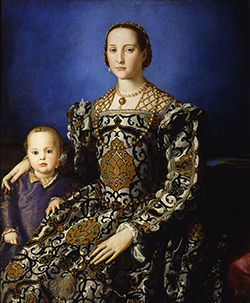 Painting by Agnolo Bronzino: Portrait of Eleanor of Toledo One of his most famous works, it is housed in the Uffizi Gallery of Florence, Italy and is considered one of the preeminent examples of Mannerist portraiture. The painting depicts Eleanor of Toledo, the wife of Cosimo I de' Medici, Grand Duke of Tuscany, sitting with her hand resting on the shoulder of one of her sons. This gesture, as well as the pomegranate motif on her dress, referred to her role as mother. Eleanor wears a heavily brocaded dress with black arabesques. In this pose, she is depicted as the ideal woman of the Renaissance.
Painting by Agnolo Bronzino: Portrait of Eleanor of Toledo One of his most famous works, it is housed in the Uffizi Gallery of Florence, Italy and is considered one of the preeminent examples of Mannerist portraiture. The painting depicts Eleanor of Toledo, the wife of Cosimo I de' Medici, Grand Duke of Tuscany, sitting with her hand resting on the shoulder of one of her sons. This gesture, as well as the pomegranate motif on her dress, referred to her role as mother. Eleanor wears a heavily brocaded dress with black arabesques. In this pose, she is depicted as the ideal woman of the Renaissance.
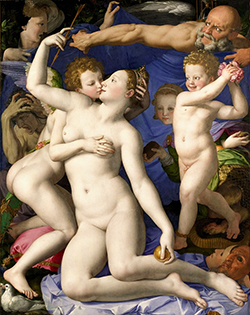 Painting by Agnolo Bronzino: Venus, Cupid, Folly and Time (also called An Allegory of Venus and Cupid and A Triumph of Venus) is an allegorical painting by the Florentine artist Agnolo Bronzino. About 1546, Bronzino was commissioned to create a painting that has come to be known as Venus, Cupid, Folly, and Time. It displays the ambivalence, eroticism, and obscure imagery that are characteristic of the Mannerist period, and of Bronzino's master Pontormo.
Painting by Agnolo Bronzino: Venus, Cupid, Folly and Time (also called An Allegory of Venus and Cupid and A Triumph of Venus) is an allegorical painting by the Florentine artist Agnolo Bronzino. About 1546, Bronzino was commissioned to create a painting that has come to be known as Venus, Cupid, Folly, and Time. It displays the ambivalence, eroticism, and obscure imagery that are characteristic of the Mannerist period, and of Bronzino's master Pontormo.
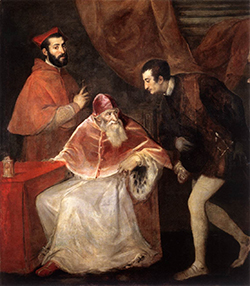 Painting by Titian: Pope Paul III and His Grandsons was commissioned by the Farnese family and painted during Titian's visit to Rome between autumn 1545 and June 1546. It depicts the thorny relationship between Pope Paul III, born Alessandro Farnese, and two of his grandsons, Ottavio and Alessandro. Ottavio is shown in the act of kneeling, to his left; Alessandro, wearing a cardinal's dress, stands behind him to his right. The painting explores the effects of ageing and the manoeuvring behind succession; Paul was at the time in his late seventies and operating within an uncertain political climate as Charles V, Holy Roman Emperor, came into ascendancy. Paul was not a religious man; he viewed the papacy as a means to consolidate his family's position. He appointed Alessandro as cardinal against accusations of nepotism, fathered a number of illegitimate children, and spent large sums of church money collecting art and antiquities.
Painting by Titian: Pope Paul III and His Grandsons was commissioned by the Farnese family and painted during Titian's visit to Rome between autumn 1545 and June 1546. It depicts the thorny relationship between Pope Paul III, born Alessandro Farnese, and two of his grandsons, Ottavio and Alessandro. Ottavio is shown in the act of kneeling, to his left; Alessandro, wearing a cardinal's dress, stands behind him to his right. The painting explores the effects of ageing and the manoeuvring behind succession; Paul was at the time in his late seventies and operating within an uncertain political climate as Charles V, Holy Roman Emperor, came into ascendancy. Paul was not a religious man; he viewed the papacy as a means to consolidate his family's position. He appointed Alessandro as cardinal against accusations of nepotism, fathered a number of illegitimate children, and spent large sums of church money collecting art and antiquities.
German minerologist Georgius Agricola publishes De Natura Fossilium (On the Nature of Fossils), the first published paleontological treatise.
1546
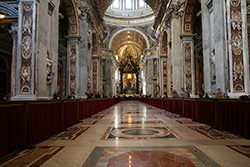 Michelangelo Buonarroti is made chief architect of St. Peter's Basilica.
Michelangelo Buonarroti is made chief architect of St. Peter's Basilica.
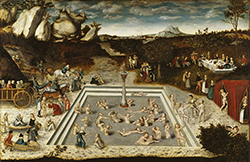 Painting by Lucas Cranach the Elder : The Fountain of Youth The image is an oil painting on a lime wood board, executed in landscape format with the dimensions 186.1 x 120.6 centimeters. It shows on the bottom center, a winged serpent in flight from Cranach's workshop and the year 1546. It shows a fountain where older women but not men bathe, are rejuvenated and finally indulge in music, dance and good food. Cranach presents in this fairy tale image, in many details the real bathing culture of the Middle Ages, that based on the belief that certain baths might heal and rejuvenate. Sensual pleasures belonged to the bathroom now.
Painting by Lucas Cranach the Elder : The Fountain of Youth The image is an oil painting on a lime wood board, executed in landscape format with the dimensions 186.1 x 120.6 centimeters. It shows on the bottom center, a winged serpent in flight from Cranach's workshop and the year 1546. It shows a fountain where older women but not men bathe, are rejuvenated and finally indulge in music, dance and good food. Cranach presents in this fairy tale image, in many details the real bathing culture of the Middle Ages, that based on the belief that certain baths might heal and rejuvenate. Sensual pleasures belonged to the bathroom now.
(no entry for this year)
1547
(no entry for this year)
(no entry for this year)
1548
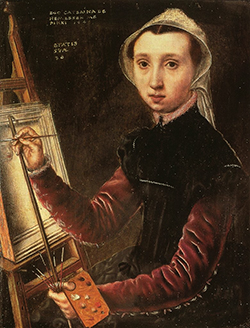 Painting by Caterina van Hemessen: Self Portrait a small painting executed in oil on oak in 1548 by the Flemish Renaissance artist Caterina van Hemessen when she was 20 years old. The painting earned her a considerable reputation during her lifetime and is significant not only for being an early modern female portrait but also for representing an artist in the act of painting. This was very unusual for the time; although self-portraits were common, only a few, like those of Albrecht Dürer (1471–1528), showed the artist's social position and everyday life. Artists of the time rarely directly referred to, much less showed the tools of their profession. Hemessen's portrait is one of the earliest in the Northern European tradition to show a painter not only with a brush but also a palette and easel. She inscribed it with the words: "I Caterina van Hemessen have painted myself / 1548 / Her aged 20".
Painting by Caterina van Hemessen: Self Portrait a small painting executed in oil on oak in 1548 by the Flemish Renaissance artist Caterina van Hemessen when she was 20 years old. The painting earned her a considerable reputation during her lifetime and is significant not only for being an early modern female portrait but also for representing an artist in the act of painting. This was very unusual for the time; although self-portraits were common, only a few, like those of Albrecht Dürer (1471–1528), showed the artist's social position and everyday life. Artists of the time rarely directly referred to, much less showed the tools of their profession. Hemessen's portrait is one of the earliest in the Northern European tradition to show a painter not only with a brush but also a palette and easel. She inscribed it with the words: "I Caterina van Hemessen have painted myself / 1548 / Her aged 20".
(no entry for this year)
1549
(no entry for this year)
ESP Quick Facts
ESP Origins
In the early 1990's, Robert Robbins was a faculty member at Johns Hopkins, where he directed the informatics core of GDB — the human gene-mapping database of the international human genome project. To share papers with colleagues around the world, he set up a small paper-sharing section on his personal web page. This small project evolved into The Electronic Scholarly Publishing Project.
ESP Support
In 1995, Robbins became the VP/IT of the Fred Hutchinson Cancer Research Center in Seattle, WA. Soon after arriving in Seattle, Robbins secured funding, through the ELSI component of the US Human Genome Project, to create the original ESP.ORG web site, with the formal goal of providing free, world-wide access to the literature of classical genetics.
ESP Rationale
Although the methods of molecular biology can seem almost magical to the uninitiated, the original techniques of classical genetics are readily appreciated by one and all: cross individuals that differ in some inherited trait, collect all of the progeny, score their attributes, and propose mechanisms to explain the patterns of inheritance observed.
ESP Goal
In reading the early works of classical genetics, one is drawn, almost inexorably, into ever more complex models, until molecular explanations begin to seem both necessary and natural. At that point, the tools for understanding genome research are at hand. Assisting readers reach this point was the original goal of The Electronic Scholarly Publishing Project.
ESP Usage
Usage of the site grew rapidly and has remained high. Faculty began to use the site for their assigned readings. Other on-line publishers, ranging from The New York Times to Nature referenced ESP materials in their own publications. Nobel laureates (e.g., Joshua Lederberg) regularly used the site and even wrote to suggest changes and improvements.
ESP Content
When the site began, no journals were making their early content available in digital format. As a result, ESP was obliged to digitize classic literature before it could be made available. For many important papers — such as Mendel's original paper or the first genetic map — ESP had to produce entirely new typeset versions of the works, if they were to be available in a high-quality format.
ESP Help
Early support from the DOE component of the Human Genome Project was critically important for getting the ESP project on a firm foundation. Since that funding ended (nearly 20 years ago), the project has been operated as a purely volunteer effort. Anyone wishing to assist in these efforts should send an email to Robbins.
ESP Plans
With the development of methods for adding typeset side notes to PDF files, the ESP project now plans to add annotated versions of some classical papers to its holdings. We also plan to add new reference and pedagogical material. We have already started providing regularly updated, comprehensive bibliographies to the ESP.ORG site.
ESP Picks from Around the Web (updated 06 MAR 2017 )
Old Science

Weird Science

Treating Disease with Fecal Transplantation
Fossils of miniature humans (hobbits) discovered in Indonesia

Dinosaur tail, complete with feathers, found preserved in amber.
Astronomy

Mysterious fast radio burst (FRB) detected in the distant universe.